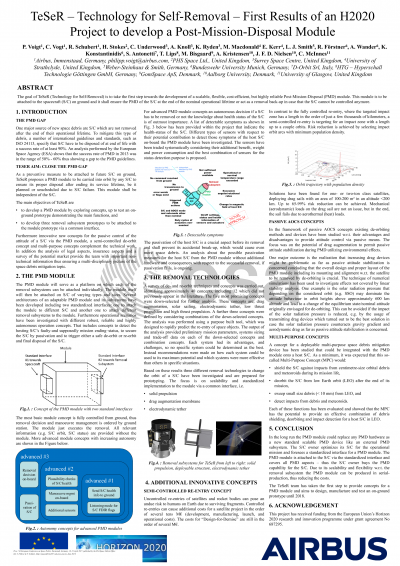Document details

Abstract
One major source of new space debris are spacecraft (S/C) which are not removed after the end of their operational lifetime. To mitigate this type of debris, a number of international guidelines and standards, such as ISO 24113, specify that S/C be disposed of at end of life with a success rate of at least 90%.
An analysis performed by the European Space Agency (ESA) shows that the success rate of Post-Mission-Disposal (PMD) in 2013 was in the range of about 50% - 60%. The reasons for the gap between the required and the actual success rate are
- Some S/C have no PMD capability.
- The equipment required for the PMD is a major design driver which increases costs and effort significantly.
- A loss of communication and/or control of the S/C (e.g. due to a failure) may lead to the inability to command the PMD by the ground station.
- The PMD of a functional S/C at the end of its nominal operational lifetime is not attractive for the S/C owner, because limiting operations also means to limit the benefits.
The goal of TeSeR (Technology for Self-Removal) is to take the first step towards the development of a cost-efficient, but highly reliable PMD module. This PMD module is to be attached to the S/C on ground and it shall ensure the PMD of the S/C at the end of the nominal operational lifetime or act as a removal back-up in case that the S/C cannot be controlled anymore. This PMD module shall be scalable and flexible, thus, enabling the PMD of any future S/C in an Earth orbit, either by de-orbit or by re-orbit, depending on the S/C and its orbit. Ultimately, the gap between the required 90 % PMD success rate and the current success rate of 50% - 60% can be closed.
The technological enhancements and developments required for successful PMD are addressed and analysed in TeSeR. The project’s primary aims are
- to develop a PMD module
- beginning with the exploration of concepts,
- going for a functional design
- to manufacture and test an on-ground prototype of the PMD module.
- to develop different removal subsystems (e.g. solid propulsion, electro-dynamical systems and deployable structures) for easy plug-in/plug-out implementation to the PMD module.
This will be the first step to demonstrate the main aspects of such a PMD module and the required main technologies. The technical activities are supported by non-technical tasks, e.g. investigation of legal issues relating to a PMD module, execution of a market study and consideration of this technology as a leverage to advance ISO norms. This double tracked approach ensures that the technological developments are embedded into the needs of the space community right from the start.
Airbus Defence and Space is the coordinator (and potential launch customer) of TeSeR. The project is conducted together with 10 notable institutes and companies from all across Europe with experts who have been working in the space debris issue for many years.
The TeSeR project contributes to solutions that will help solve the space debris issue to ensure a sustainable space environment for future generations. It is funded by the European Commission in the H2020 framework with almost EUR 3 million (grant agreement number 687295). It started in February 2016 and runs until January 2019.
The paper describes the project and first results in greater detail.
Preview


